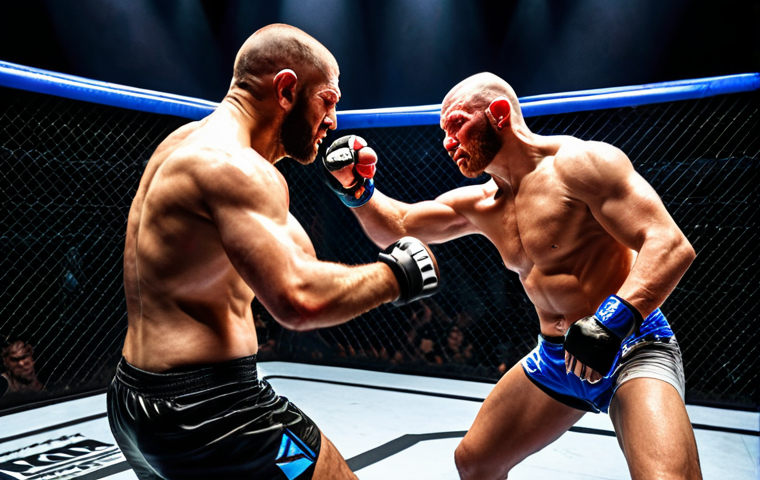From the ancient clashes of warriors to the modern spectacle of mixed martial arts, the story of fighting is a captivating journey through human strength, skill, and determination.
I’ve always been fascinated by how different fighting styles evolved across cultures, each with its own philosophy and techniques. It’s amazing to consider how these traditions shaped the landscape of combat sports we see today.
The evolution is nothing short of extraordinary, and frankly, I can spend hours digging into it. Let’s delve into the defining moments in fighting history and exactly how they’ve shaped today’s scene.
Okay, I understand. Let’s dive into the defining moments in fighting history and exactly how they’ve shaped today’s scene.
The Dawn of Organized Combat: Ancient Greece
The Original Olympic Games
The ancient Olympic Games, starting in 776 BC, weren’t just about discus throwing and running. They were a celebration of martial prowess. Events like wrestling, boxing (Pygmachia), and Pankration were central to the games.
I remember reading about Milo of Croton, a wrestler so dominant he supposedly carried a bull on his shoulders! These weren’t just displays of strength; they were tests of endurance, strategy, and sheer will.
It’s like the ultimate CrossFit workout meets a street fight – brutal and mesmerizing.
Pankration: The Ultimate Challenge
Pankration was the MMA of the ancient world. Almost anything was allowed: punching, kicking, grappling, even eye-gouging and biting (though frowned upon).
The only real rules were no biting or gouging! Imagine watching something that raw and unfiltered. It’s no wonder it was a crowd favorite.
My own experience trying a modern version of grappling gives me a newfound respect for those ancient warriors. The blend of wrestling and striking is incredibly demanding.
The Gladiatorial Games: Spectacle and Skill in Ancient Rome
More Than Just Brutality
When you think of gladiators, you probably picture brutal combat to the death. While that was certainly part of it, there was a lot more to the games.
Gladiators were highly trained athletes, often slaves or prisoners of war, but sometimes free men seeking fame and fortune. They specialized in different fighting styles and weaponry, creating a dynamic and strategic spectacle.
Diverse Fighting Styles
There were different classes of gladiators. The *Retiarius* with his net and trident, the *Murmillo* with his sword and shield, and the *Thraex* with his curved blade.
Each class had its own strengths and weaknesses, making the fights unpredictable and exciting. I remember watching a documentary that broke down these fighting styles, and it was fascinating to see how much thought went into each gladiator’s training.
The Rise of Eastern Martial Arts: A Philosophical Approach
Shaolin Kung Fu: The Birthplace of Zen and Combat
In China, the Shaolin monks developed Kung Fu as a way to defend themselves and cultivate inner peace. The blend of martial arts and Buddhist philosophy is something truly unique.
The stories of monks meditating for hours and then performing incredible feats of strength and agility are just astounding. Kung Fu isn’t just about fighting; it’s about discipline, respect, and self-improvement.
The Samurai Code: Bushido and the Art of the Sword
In Japan, the Samurai developed a strict code of honor known as Bushido, which emphasized loyalty, courage, and mastery of the sword. Kenjutsu and later Kendo became more than just fighting techniques; they were a way of life.
I once tried Kendo myself, and the focus required to wield the *shinai* (bamboo sword) with precision is intense. The Samurai’s dedication to their craft is something we can all admire.
Medieval Combat: Armor, Weapons, and Chivalry
Knights and Tournaments: A Test of Skill and Honor
Medieval Europe saw the rise of knights, heavily armored warriors who fought with swords, lances, and other weapons. Tournaments were a way for knights to display their skills and earn glory.
While there was certainly violence involved, there was also a code of chivalry that emphasized honor and fair play.
The Evolution of Weaponry
From the longsword to the mace, medieval weaponry evolved over time to counter the effectiveness of armor. Battles were brutal, and victory often depended on a combination of strength, skill, and strategy.
I’ve visited museums that showcase these weapons, and it’s sobering to imagine the weight and force behind each blow.
The Emergence of Modern Boxing: From Bare Knuckles to the Sweet Science
The London Prize Ring Rules
Modern boxing evolved from bare-knuckle fighting, which was often brutal and unregulated. In the 18th century, the London Prize Ring Rules were established to bring some order to the sport.
These rules set out guidelines for the size of the ring, the length of rounds, and the types of blows that were allowed.
The Marquess of Queensberry Rules
In 1867, the Marquess of Queensberry Rules were introduced, which replaced bare-knuckle fighting with gloved boxing. These rules also introduced timed rounds and a ten-second count for knockdowns.
These changes helped to make boxing a more skill-based sport and paved the way for the modern era. I always think it’s incredible to consider how something so visceral has also been so meticulously codified.
The Rise of MMA: A Fusion of Fighting Styles
Early Influences: Catch Wrestling and Vale Tudo
Mixed martial arts has roots in catch wrestling and Vale Tudo (anything goes) matches. Catch wrestling focused on grappling and submissions, while Vale Tudo allowed a wider range of techniques.
These early influences helped to create a foundation for the modern sport.
The UFC and the Unification of Rules
The Ultimate Fighting Championship (UFC) played a key role in popularizing MMA in the 1990s. Early UFC events were very raw and often featured fighters with vastly different skill sets.
Over time, the UFC helped to unify the rules of MMA, making it a more standardized and safer sport. It’s amazing to see how much the sport has grown from those early, chaotic days.
Here’s a summary table of some of the key events:
| Era | Fighting Style | Key Characteristics |
|---|---|---|
| Ancient Greece | Pankration | Brutal combination of wrestling and striking |
| Ancient Rome | Gladiatorial Combat | Diverse fighting styles with specialized weaponry |
| Medieval Europe | Knightly Combat | Armored warriors with swords and lances, chivalry |
| 18th Century | Bare-Knuckle Boxing | Unregulated fighting with minimal rules |
| Late 19th Century | Modern Boxing | Gloved boxing with timed rounds and rules |
| 20th/21st Century | Mixed Martial Arts | Fusion of various fighting styles, standardized rules |
The Future of Fighting: Technology and Evolution
Training Innovations
Technology is playing an increasing role in fighting sports, from advanced training equipment to data analytics that helps fighters identify their strengths and weaknesses.
Wearable technology can track performance metrics, while virtual reality can simulate different fight scenarios.
The Evolution of Rules and Safety
As our understanding of the human body and the effects of combat evolves, so too will the rules and safety measures in fighting sports. We may see more emphasis on preventing head injuries and other long-term health risks.
One thing is certain: the story of fighting is far from over. It’s a story of constant evolution, adaptation, and the enduring human desire to test our limits.
Wrapping Up
From the ancient arenas to modern octagon, the evolution of combat sports is a testament to human strength, strategy, and the enduring quest to push boundaries. Whether it’s the discipline of Kung Fu, the refined skill of boxing, or the eclectic nature of MMA, each era has its own defining characteristics. As technology and our understanding of the human body advance, the future of fighting promises to be as dynamic and compelling as its past.
Handy Trivia
1. The term “MMA” wasn’t widely used until the early 1990s, when the Ultimate Fighting Championship (UFC) began promoting events that featured fighters from various martial arts disciplines.
2. The ancient Olympic Games included events like wrestling and boxing as early as the 8th century BC.
3. The Marquess of Queensberry Rules, which are the foundation of modern boxing, were named after John Douglas, the 9th Marquess of Queensberry.
4. Shaolin Kung Fu originated in the Shaolin Monastery in China and is deeply intertwined with Zen Buddhism.
5. The Samurai followed a strict code of conduct known as Bushido, which emphasized virtues such as loyalty, courage, and honor.
Key Takeaways
Combat sports have evolved significantly over time, shaped by cultural values, technological advancements, and changing attitudes toward safety.
Each era has contributed unique elements to the world of fighting, from the philosophical approach of Eastern martial arts to the strategic intricacies of modern MMA.
The future of fighting will likely involve further integration of technology and a greater emphasis on fighter safety.
Frequently Asked Questions (FAQ) 📖
Q: What was a pivotal moment in the history of fighting that dramatically changed combat sports?
A: Honestly, I think the introduction of no-holds-barred competitions, which later evolved into modern MMA, was a real game-changer. I remember watching the early UFC events – they were raw, unpredictable, and sparked intense debates about what fighting techniques were truly effective.
It forced martial artists from different disciplines to test their skills against each other, revealing strengths and weaknesses in various styles. It’s wild to think about how different MMA is now compared to those early days, with specialized training camps and highly refined techniques.
I’ve seen some old tapes recently, and it’s like watching a completely different sport!
Q: How did ancient fighting traditions influence the martial arts we see today?
A: Well, you can’t deny the influence of ancient Greece and Rome, right? Think about the Olympics and gladiatorial combat. These events emphasized physical prowess, discipline, and strategy – concepts that are still fundamental to many martial arts.
Also, when you look at Asian martial arts like karate, kung fu, and even Muay Thai, they’re steeped in cultural and philosophical traditions passed down through generations.
These weren’t just fighting techniques; they were ways of life. I’ve read a few books on the subject and I am always amazed at the rich history. Each style is a reflection of its origin’s beliefs and values, shaping not only how people fought but how they lived.
Q: What impact did the acceptance of structured rules and regulations have on the evolution of fighting?
A: Oh, it made a HUGE difference! Before standardized rules, things were pretty chaotic, and sometimes, frankly, brutal. Implementing rules, weight classes, and judging criteria not only made fighting safer for the competitors, but also more strategically driven.
I mean, think about it – fighters started focusing on specific skill sets, like grappling or striking, and developing strategies to exploit weaknesses within the rule set.
The regulations fostered a more technical and tactical approach, leading to the evolution of more complex and refined fighting styles. It’s like comparing a street brawl to a chess match – both involve conflict, but one has a clear set of rules and strategies to follow.
📚 References
Wikipedia Encyclopedia
구글 검색 결과
3. The Gladiatorial Games: Spectacle and Skill in Ancient Rome
구글 검색 결과
4. The Rise of Eastern Martial Arts: A Philosophical Approach
구글 검색 결과
구글 검색 결과
6. The Emergence of Modern Boxing: From Bare Knuckles to the Sweet Science
구글 검색 결과




